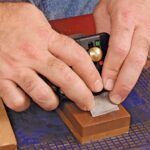Is your SRAM Guide RE brake lever feeling spongy or pulling all the way to the handlebar? It’s likely time for a brake bleed. This comprehensive guide, brought to you by CONDUCT.EDU.VN, walks you through the process of bleeding your SRAM Guide RE brakes, ensuring optimal performance and safety. Master hydraulic brake maintenance and enjoy consistent stopping power with this detailed SRAM brake bleeding tutorial.
1. Understanding the Need for Bleeding SRAM Guide RE Brakes
Hydraulic disc brakes, like those found on mountain bikes, rely on brake fluid to transmit force from the lever to the caliper. Over time, air bubbles can accumulate within the system, compromising braking performance. This can happen due to:
- Age: Brake fluid absorbs moisture, lowering its boiling point and leading to air bubble formation.
- Leaks: Small leaks in the system can introduce air.
- Overheating: Extreme braking can boil the fluid, creating air bubbles.
Bleeding your SRAM Guide RE brakes removes these air bubbles and replaces the old fluid with fresh fluid, restoring proper function.
2. Identifying the Symptoms: When to Bleed Your Brakes
Recognizing the signs of air in your brake lines is crucial for maintaining your bike’s safety and performance. Here are some key indicators that your SRAM Guide RE brakes need bleeding:
- Spongy or Mushy Lever Feel: The brake lever feels soft and requires excessive travel before engaging the brakes.
- Inconsistent Bite Point: The point at which the brakes engage varies.
- Lever Pulls to the Handlebar: In extreme cases, the lever might pull all the way to the handlebar without providing adequate braking force.
- Reduced Braking Power: Overall braking performance is diminished.
- Unusual Noises: Squealing or grinding sounds can sometimes indicate air in the system.
If you experience any of these symptoms, it’s best to bleed your brakes as soon as possible.
3. Essential Tools and Materials for SRAM Guide RE Brake Bleeding
Before you begin, gather the necessary tools and materials. Using the right equipment will make the process smoother and more efficient. Here’s what you’ll need:
- SRAM/Avid Bleed Kit: This kit includes syringes, fittings, and bleed blocks specifically designed for SRAM brakes. (Bleed Kit)
- DOT 5.1 Brake Fluid: Use only DOT 5.1 brake fluid, as recommended by SRAM. Never use DOT 4 fluid, as it’s incompatible and can damage the brake system.
- Gloves: Protect your hands from brake fluid.
- Protective Glasses: Prevent brake fluid from splashing into your eyes.
- Isopropyl Alcohol: For cleaning up any spills.
- Shop Rags: For wiping up excess fluid.
- Torx Wrenches: T25 and T10 Torx wrenches for removing and installing bleed screws.
- Zip Ties or Rubber Bands: To secure the brake lever.
- Bleed Block: To hold the brake pads in place during the bleeding process.
4. Preparing Your Bike and Work Area
A well-prepared workspace will make the bleeding process much easier. Follow these steps:
- Clean Your Bike: Wipe down the brake lever, caliper, and surrounding areas to prevent dirt from contaminating the system.
- Secure Your Bike: Place your bike in a stand or lean it against a stable surface.
- Protect Surfaces: Cover your work area with a drop cloth or paper towels to catch any spills.
- Remove the Wheels: Take both wheels off the bike for better access to the calipers.
5. Step-by-Step Guide to Bleeding SRAM Guide RE Brakes
Follow these detailed steps to properly bleed your SRAM Guide RE brakes:
5.1. Preparing the Syringes
- Fill the Syringes: Fill one syringe about halfway with fresh DOT 5.1 brake fluid and the other about one-third full.
- Remove Air from Syringes: Hold the syringes upright and gently tap them to encourage air bubbles to rise to the top. Then, carefully push the air out of the syringes. Repeat this process until no more air bubbles appear. This step is critical to ensure you are not introducing more air into the brake system.
5.2. Adjusting the Brake Lever
- Set Bite Point Adjuster: If your SRAM Guide RE brakes have a bite point adjuster, turn it to the maximum position (furthest away from the handlebar). This ensures that the entire system is bled properly.
5.3. Preparing the Caliper
- Remove Brake Pads: Take out the brake pads from the caliper. Depending on the condition of your pads, you’ll either use a transport guard (for new pads) or a bleed block (for worn pads).
- Install Bleed Block: Insert the bleed block into the caliper. This holds the pistons in place and prevents them from extending too far during the bleeding process.
5.4. Connecting the Syringes
- Locate Bleed Screws: Find the bleed screws on the brake lever and the caliper. They are typically small screws with Torx heads.
- Attach Syringe to Caliper: Remove the bleed screw from the caliper and attach the syringe filled with brake fluid. Make sure the connection is secure.
- Attach Syringe to Lever: Remove the bleed screw from the brake lever and attach the other syringe.
5.5. Bleeding the Brakes
- Push Fluid from Caliper to Lever: Gently push fluid from the syringe at the caliper towards the lever. Watch for air bubbles entering the syringe at the lever. Continue until no more air bubbles are visible.
- Secure the Brake Lever: Use a zip tie or rubber band to hold the brake lever close to the handlebar. This helps to release any trapped air in the master cylinder.
3. Create Vacuum at Caliper: Gently pull a vacuum on the syringe at the caliper to draw out any remaining air.
4. Release Lever and Build Pressure: Release the zip tie or rubber band, allowing the lever to return to its normal position. Simultaneously, apply pressure to the syringe at the caliper.
5.6. Finalizing the Bleed
- Close the Lever Syringe: Close off the syringe at the brake lever.
- Remove Caliper Syringe and Reinstall Screw: Detach the syringe from the caliper and reinstall the bleed screw.
- Create Vacuum at Lever: Pull a slight vacuum on the syringe at the brake lever to bleed the lever itself.
- Remove Lever Syringe and Reinstall Screw: Remove the syringe from the brake lever and reinstall the bleed screw.
5.7. Cleaning and Reassembly
- Clean the Lever and Caliper: Use isopropyl alcohol and a clean rag to wipe down the brake lever and caliper, removing any spilled brake fluid.
- Reinstall Brake Pads: Put the brake pads back into the caliper.
- Reinstall Wheels: Reattach the wheels to your bike.
6. Troubleshooting Common Issues
Even with careful attention, you might encounter some problems during the bleeding process. Here are some common issues and how to resolve them:
- Air Bubbles Persist: If you continue to see air bubbles after multiple attempts, check all connections for leaks. Ensure that the syringes are properly sealed and that the bleed screws are tightened securely.
- Fluid Leaks: If you notice brake fluid leaking from any of the connections, tighten the fittings or replace the O-rings.
- Spongy Lever Feel Remains: If the lever still feels spongy after bleeding, repeat the process. Make sure you are thoroughly removing air from both the caliper and the lever.
- Contaminated Brake Pads: If brake fluid contaminates your brake pads, they will need to be replaced. Contaminated pads will not provide adequate braking power.
7. Tips and Best Practices for Effective Brake Bleeding
To ensure a successful brake bleed and optimal braking performance, consider these tips:
- Use Fresh Brake Fluid: Always use fresh, unopened brake fluid. Brake fluid absorbs moisture from the air, which can compromise its performance.
- Work in a Clean Environment: A clean work area will help prevent contamination of the brake system.
- Be Patient: Bleeding brakes can take time and patience. Don’t rush the process.
- Follow SRAM’s Instructions: Always refer to SRAM’s official documentation for specific instructions and recommendations.
- Regular Maintenance: Bleed your brakes at least once a year, or more frequently if you ride in wet or muddy conditions.
8. Importance of Proper Brake Maintenance
Maintaining your brakes is essential for your safety and the longevity of your bike. Properly functioning brakes provide reliable stopping power and control, allowing you to ride with confidence. Regular brake bleeding, along with other maintenance tasks like checking brake pads and rotor alignment, will keep your brakes in top condition.
9. Why Choose CONDUCT.EDU.VN for Your Maintenance Needs
At CONDUCT.EDU.VN, we are committed to providing you with accurate, reliable, and easy-to-understand guides for all your bike maintenance needs. Our step-by-step instructions, expert tips, and troubleshooting advice will help you keep your bike running smoothly and safely. We understand the challenges cyclists face and strive to offer practical solutions that empower you to maintain your equipment effectively.
We adhere to the highest standards of E-E-A-T (Experience, Expertise, Authoritativeness, and Trustworthiness) and YMYL (Your Money or Your Life) to ensure that the information we provide is both accurate and trustworthy. Our content is thoroughly researched and reviewed to meet these standards.
10. Safety Precautions
When working with brake fluid, it’s important to take certain safety precautions:
- Wear Gloves and Eye Protection: Brake fluid can irritate your skin and eyes.
- Work in a Well-Ventilated Area: Brake fluid fumes can be harmful.
- Dispose of Used Brake Fluid Properly: Brake fluid is hazardous waste and should not be poured down the drain. Contact your local waste management facility for proper disposal instructions.
- Keep Brake Fluid Away from Children: Brake fluid is toxic and should be stored out of reach of children.
11. Common Brake System Issues and Troubleshooting
Beyond bleeding, other brake system issues can affect performance. Here’s a brief troubleshooting guide:
| Issue | Possible Cause(s) | Solution(s) |
|---|---|---|
| Squealing Brakes | Contaminated pads, misaligned caliper, worn rotors | Clean or replace pads, realign caliper, replace rotors |
| Pulsating Brakes | Warped rotor, contaminated pads | Replace rotor, clean or replace pads |
| Weak Braking Power | Contaminated pads, air in system, worn pads, glazed rotor | Clean or replace pads, bleed brakes, replace pads, deglaze rotor |
| Brake Lever Sticking | Dirty or damaged master cylinder | Clean or replace master cylinder |
| Dragging Brakes | Misaligned caliper, sticking pistons | Realign caliper, clean and lubricate pistons |
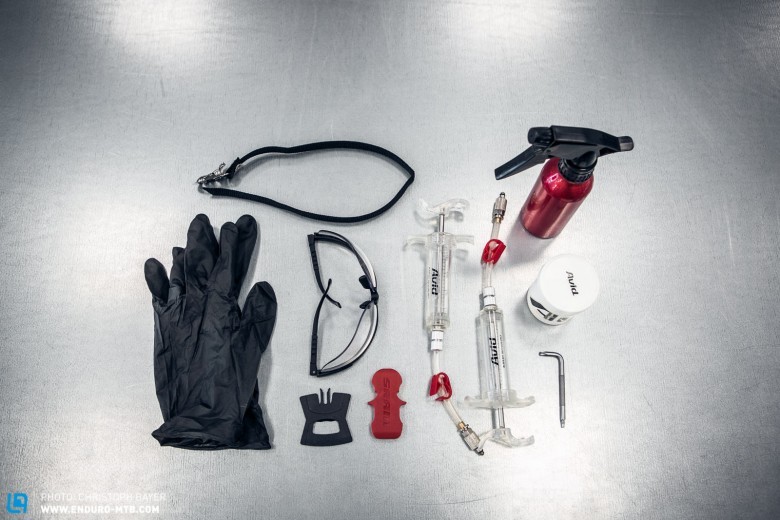
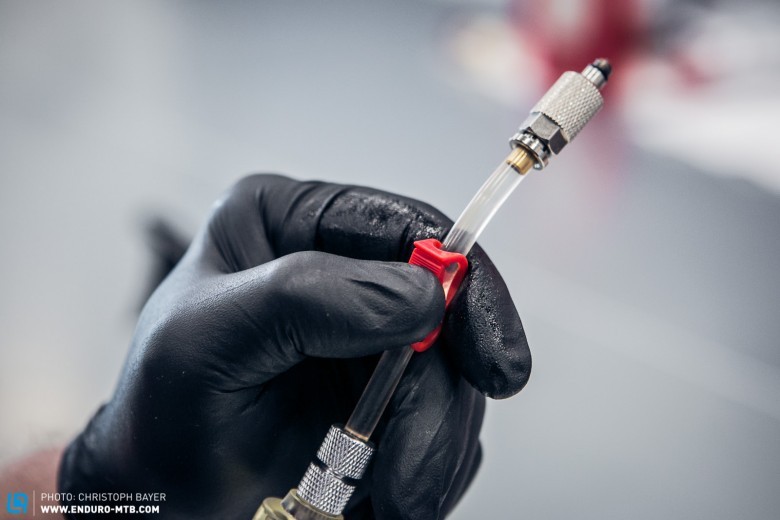
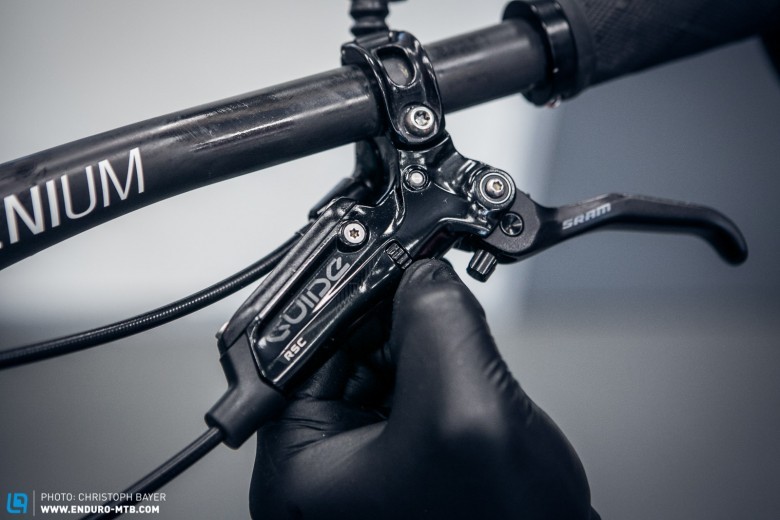
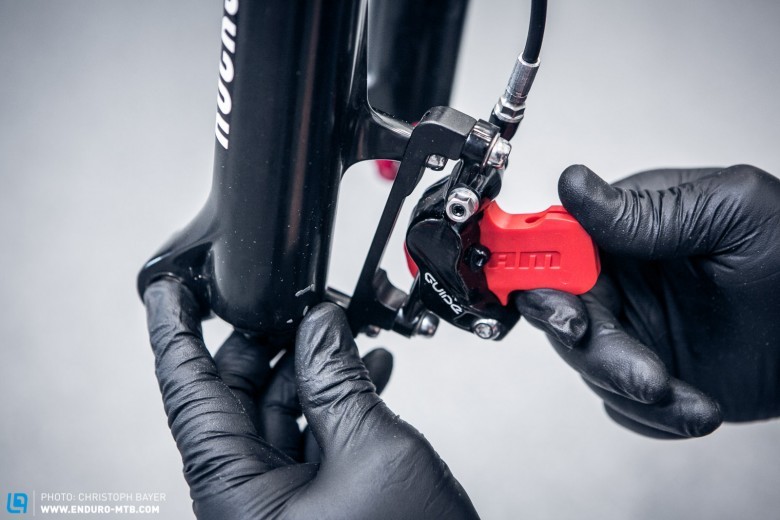
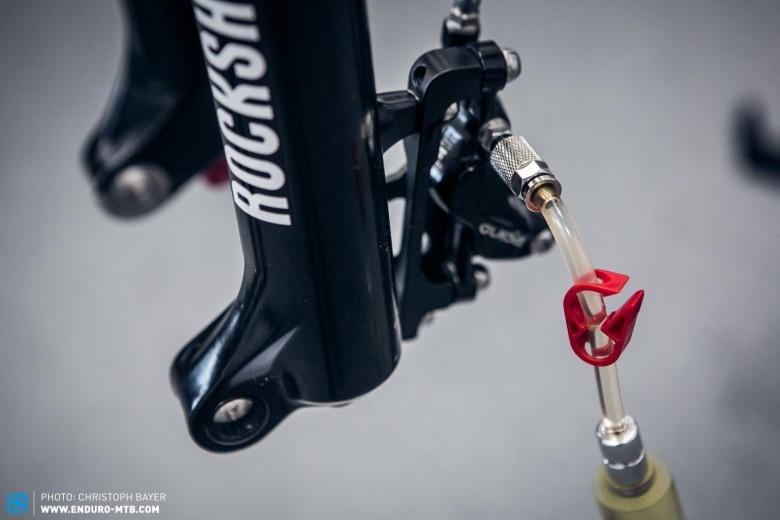
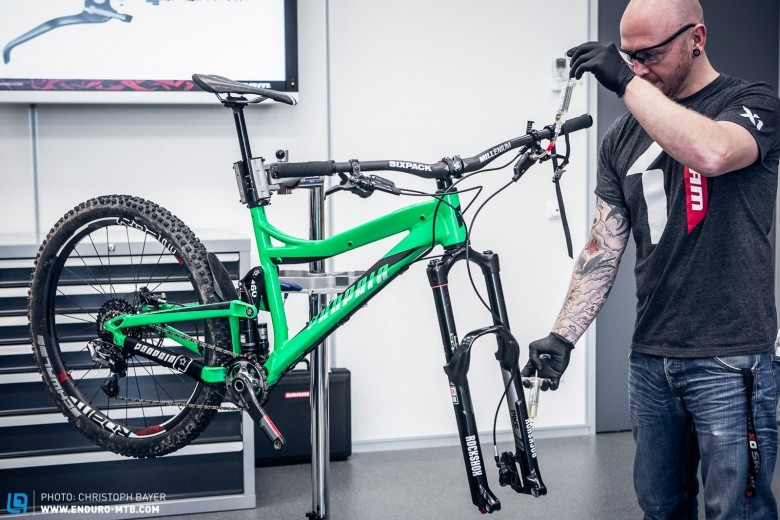
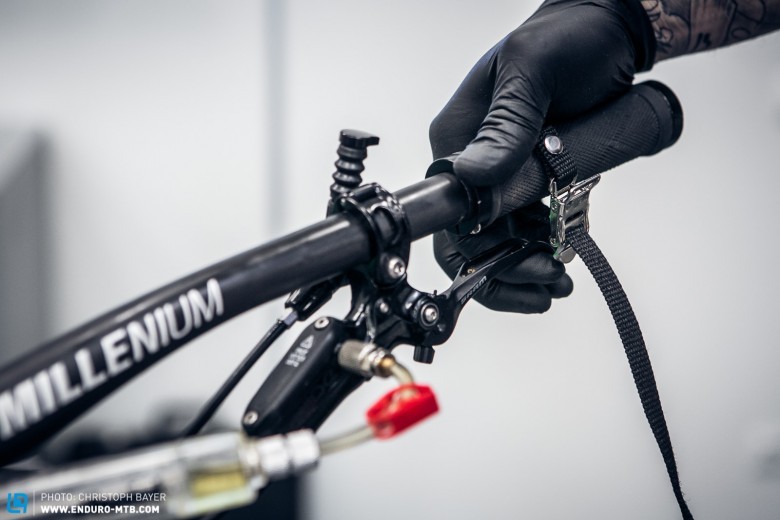
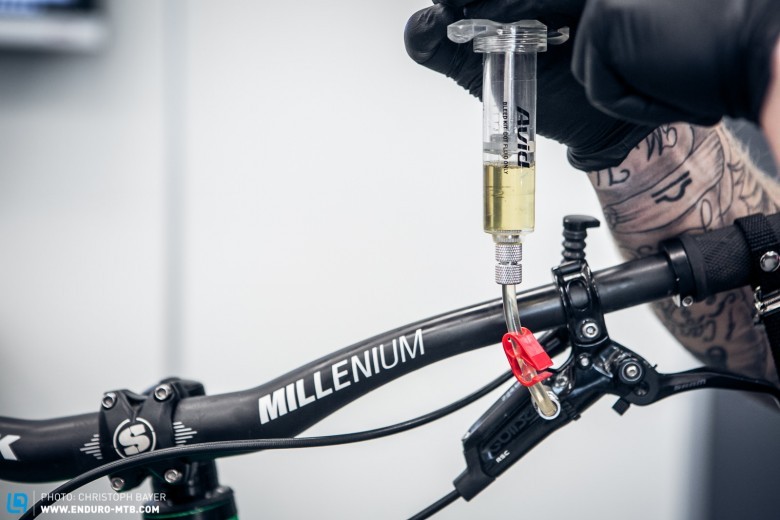
12. Advanced Techniques for Optimizing Brake Performance
Once you’ve mastered the basics of bleeding, consider these advanced techniques:
- Lever Positioning: Experiment with different lever positions to find the most comfortable and effective setup for your hands.
- Reach Adjustment: Adjust the lever reach to match your finger length.
- Bite Point Adjustment (If Applicable): Fine-tune the bite point to suit your riding style.
- Pad and Rotor Selection: Choose brake pads and rotors that match your riding conditions and preferences.
13. The Science Behind Hydraulic Brakes
Understanding how hydraulic brakes work can help you appreciate the importance of proper maintenance. Hydraulic brakes use Pascal’s Law, which states that pressure applied to a confined fluid is transmitted equally throughout the fluid. In a brake system:
- Lever Application: When you squeeze the brake lever, you apply pressure to the master cylinder.
- Fluid Transmission: The pressure is transmitted through the brake fluid to the caliper pistons.
- Piston Activation: The pistons push the brake pads against the rotor, creating friction and slowing the bike.
Air bubbles in the system compress under pressure, reducing the efficiency of fluid transmission and resulting in a spongy lever feel and diminished braking power.
14. Real-World Examples of Brake Maintenance Impact
Consider these scenarios:
- Scenario 1: The Weekend Warrior: A mountain biker neglects to bleed their brakes for two years. During a steep descent, their brakes fade, leading to a near-miss collision.
- Scenario 2: The Commuter: A city cyclist notices their brakes feeling soft. They bleed the brakes and discover a significant improvement in stopping power, making their commute safer.
- Scenario 3: The Racer: An enduro racer regularly bleeds their brakes to ensure consistent performance. This gives them a competitive edge and prevents brake fade during long descents.
These examples highlight the real-world impact of proper brake maintenance on safety and performance.
15. Addressing Environmental Concerns
Proper disposal of brake fluid is essential for protecting the environment. Brake fluid contains chemicals that can contaminate soil and water. Follow these guidelines:
- Never Pour Brake Fluid Down the Drain: Take used brake fluid to a local recycling center or hazardous waste disposal facility.
- Store Brake Fluid Properly: Keep brake fluid in a tightly sealed container to prevent spills and leaks.
- Clean Up Spills Immediately: Use absorbent materials like shop rags to clean up any spills.
16. Staying Updated with Brake Technology
Brake technology is constantly evolving. Stay informed about the latest advancements by:
- Reading Industry Publications: Follow mountain bike and cycling news sources.
- Attending Workshops and Clinics: Participate in hands-on maintenance workshops.
- Consulting with Experts: Seek advice from experienced mechanics and riders.
- Visiting CONDUCT.EDU.VN: Check our website for updated guides and information.
17. Brake Bleeding Frequency: A Tailored Approach
The frequency with which you should bleed your SRAM Guide RE brakes depends on several factors:
- Riding Style: Aggressive riders who frequently use their brakes will need to bleed them more often.
- Riding Conditions: Wet, muddy, or dusty conditions can accelerate brake fluid contamination.
- Brake Usage: Riders who live in mountainous areas and frequently descend steep hills will need to bleed their brakes more often.
- Fluid Type: Some brake fluids are more prone to absorbing moisture than others.
- Manufacturer Recommendations: Always follow the manufacturer’s recommendations for brake bleeding frequency.
As a general guideline, it’s a good idea to bleed your brakes at least once a year, or more frequently if you notice any of the symptoms mentioned earlier in this guide.
18. Impact of Altitude on Brake Performance
Altitude can affect brake performance due to changes in air pressure and temperature. At higher altitudes, the boiling point of brake fluid decreases, making it more susceptible to boiling and creating air bubbles. If you frequently ride at high altitudes, consider using a high-performance brake fluid with a higher boiling point.
19. Conduct.edu.vn: Your Partner in Ethical and Safe Cycling
At Conduct.edu.vn, we’re not just about bike maintenance. We’re dedicated to promoting ethical conduct and safe practices in all aspects of cycling. This includes responsible riding habits, respect for other trail users, and proper maintenance of your equipment to ensure your safety and the safety of others.
20. Summary: Mastering SRAM Guide RE Brake Bleeding
Bleeding your SRAM Guide RE brakes is a crucial maintenance task that ensures optimal braking performance and safety. By following this comprehensive guide, you can confidently perform this task yourself and keep your brakes in top condition. Remember to use the right tools and materials, follow the steps carefully, and take the necessary safety precautions.
Is your SRAM Guide RE brake lever feeling spongy or pulling all the way to the handlebar? CONDUCT.EDU.VN offers comprehensive guidance, walking you through bleeding your brakes for optimal performance and safety, offering insights into bicycle upkeep, SRAM brake servicing, and ways to enhance your stopping power. Explore our resources at CONDUCT.EDU.VN to elevate your knowledge and ensure your braking system functions flawlessly. Enhance your bike maintenance skills and keep your bicycle running smoothly. Learn about hydraulic brake maintenance, SRAM brake bleeding, and consistent stopping power.
For further assistance or more detailed information, please contact us at:
CONDUCT.EDU.VN
Address: 100 Ethics Plaza, Guideline City, CA 90210, United States
WhatsApp: +1 (707) 555-1234
Website: conduct.edu.vn
Frequently Asked Questions (FAQ)
1. How often should I bleed my SRAM Guide RE brakes?
At least once a year, or more frequently if you notice a spongy lever feel or reduced braking power.
2. Can I use DOT 4 brake fluid in my SRAM Guide RE brakes?
No, only use DOT 5.1 brake fluid. DOT 4 is incompatible and can damage the system.
3. What is a bleed block, and why do I need it?
A bleed block holds the brake pistons in place during the bleeding process, preventing them from extending too far.
4. What do I do if brake fluid gets on my brake pads?
Replace the brake pads. Contaminated pads will not provide adequate braking power.
5. How do I dispose of used brake fluid?
Take it to a local recycling center or hazardous waste disposal facility.
6. What causes air bubbles to get into my brake system?
Age, leaks, and overheating can all cause air bubbles to form.
7. Can I reuse brake fluid that I’ve already opened?
No, always use fresh, unopened brake fluid.
8. What is the purpose of the bite point adjuster on my brake lever?
It allows you to adjust the point at which the brakes engage.
9. Do I need to remove the wheels to bleed my brakes?
Removing the wheels provides better access to the calipers and makes the process easier.
10. What should I do if I’m still having trouble bleeding my brakes?
Consult with a professional bike mechanic.

